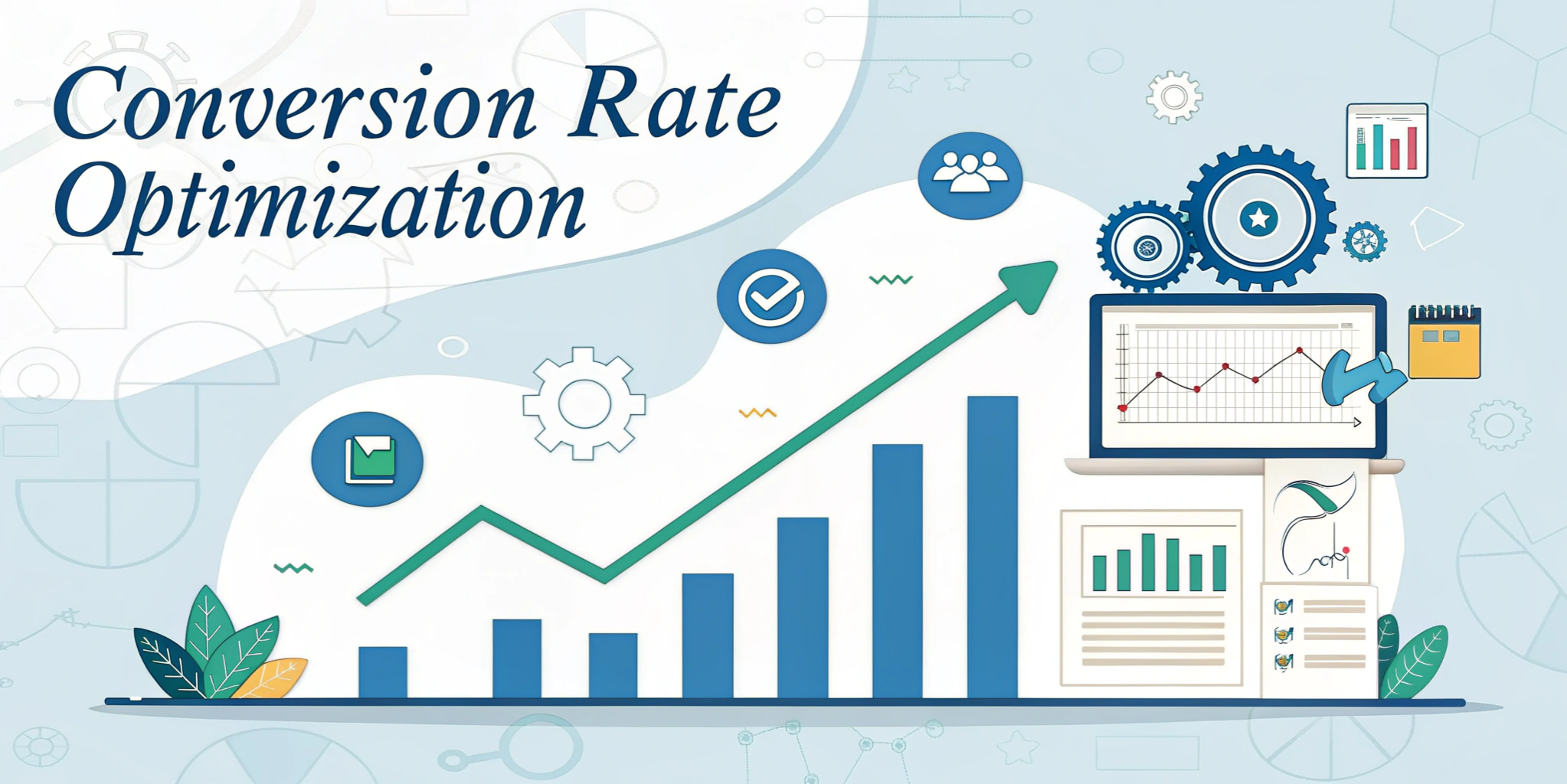Introduction to Conversion Rate Optimization (CRO)
In today's competitive digital landscape, simply driving traffic to your website is not enough. The key to maximizing your business success lies in converting those visitors into paying customers. This is where Conversion Rate Optimization (CRO) comes into play. CRO is the art and science of optimizing different elements of your website or landing pages to increase the probability of visitors taking the desired actions, such as making a purchase, signing up for a newsletter, or filling out a form.
By improving the experience users have while navigating your site, you can boost your sales without the need for additional traffic. Ultimately, CRO helps businesses make the most of their existing audience, enhancing the efficiency of their marketing efforts.
What is Conversion Rate Optimization?
Conversion Rate Optimization (CRO) is a process focused on improving the user experience on your website with the goal of turning more visitors into customers. This includes understanding how visitors interact with your website, analyzing their behaviors, identifying barriers that prevent conversions, and testing changes to optimize performance.
The process typically involves:
- Analyzing visitor behavior using analytics tools.
- Identifying key performance indicators (KPIs) that affect conversions.
- Testing and repeating different strategies to improve conversion rates.
Key actions include redesigning a landing page, improving site navigation, enhancing call-to-action (CTA) buttons, or implementing targeted messaging based on user data.
Why CRO is Essential for Your Business Growth
Investing time and resources in CRO can have a significant impact on your bottom line. Here's why:
- Increase Revenue without Increasing Traffic Costs: Instead of continually spending more on ads and campaigns, CRO allows you to get more value from your existing traffic, increasing the efficiency of your marketing budget.
- Improved User Experience and Engagement: A seamless and enjoyable user experience encourages visitors to stay on your site longer and increases the chances they'll complete a conversion action.
- Deeper Insights into Customer Behavior: CRO allows you to learn more about your audience's preferences and behaviors, enabling you to make better business decisions.
- Stay Competitive: In industries where competition is fierce, CRO is a valuable tool for differentiating your business. A well-optimized site can make the difference between a visitor choosing you or your competitor.
Understanding Your Audience
Effective CRO begins with understanding who your visitors are and what motivates them to take action. Identifying these key insights helps you tailor your site to their needs.
Identifying Your Target Customers
To optimize your website for conversions, you first need to define your ideal customer clearly. This involves understanding:
- Demographics: Age, gender, location, income level, etc.
- Interests and Behaviors: What interests your target audience? What online habits do they have?
- Pain Points and Challenges: What problems does your target audience face, and how can your product or service help solve them?
Understanding these factors will help you craft messages, offers, and experiences that resonate with your audience.
Analyzing User Behavior and Pain Points
A crucial part of CRO is analyzing how visitors interact with your site. You can use tools like Google Analytics, heatmaps, and customer surveys to:
- Track where users drop off in the sales funnel.
- Identify areas where users struggle or get frustrated.
- Uncover opportunities for improvement.
Key Elements of CRO
To enhance your website's conversion rate, several elements should be optimized. Let's look at some of the most important ones.
Optimizing Landing Pages for Higher Conversions
Your landing page is the first thing visitors see when they arrive at your site. A strong landing page can make the difference between a bounce and a sale. Key factors to focus on include:
- A Clear, Compelling Headline: Make sure the headline clearly communicates the value you offer.
- A Concise, Value-Driven Message: Provide value upfront and explain how your product or service solves the user's problem. <!--
- A Strong Call-to-Action (CTA): Use action-oriented language (e.g., "Buy Now" or "Sign Up Today").
- Trust Signals: Incorporate trust-building elements like customer testimonials, security badges, and recognizable brand logos.
🚀 New Batch Starting Soon!
Don't miss your chance to enroll now.
Crafting Effective Call-to-Actions (CTAs)
A well-crafted CTA guides users toward conversion. It should be:
- Clear and Action-Oriented: Phrases like "Start Your Free Trial” or "Get Instant Access" are great examples.
- Visually Distinct: Make your CTA button stand out using contrasting colors or bold design.
- Strategically Positioned: Ensure the CTA is placed where visitors can easily find it, often at the top of the page, within the body, or at the end of the content.
The Role of Website Design and User Experience (UX)
An intuitive and seamless user experience is essential for conversions. Prioritize:
- Fast Page Load Speed: Websites that load in under three seconds tend to have higher conversion rates.
- Mobile Responsiveness: Ensure your website works seamlessly on mobile devices, as many users browse and shop on their phones.
- Easy Navigation: Organize your site's structure so users can find information and make purchases without frustration.
Strategies to Boost Conversion Rates
Here are a few proven strategies that can dramatically increase your conversion rates:
A/B Testing: How to Experiment for Better Results
A/B testing is a method of comparing two versions of a webpage or element to see which performs better. Test:
- Headlines: Does a more attention-grabbing headline increase conversions?
- CTA Buttons: Try different button texts or colors to see what resonates with users.
- Images and Videos: Does a product image or explainer video lead to higher engagement?
Leveraging Personalization for Increased Engagement
Personalization has become an essential factor in driving conversions. Dynamic content based on user data can boost engagement, such as:
- Personalized Product Recommendations: Show users products based on their browsing history or preferences.
- Custom Landing Pages: Create landing pages tailored to different user segments or behaviors.
Reducing Bounce Rate and Exit Intent Strategies
A high bounce rate means users are leaving your site without taking any action. Reduce bounce rates by:
- Offering value immediately upon arrival (e.g., clear messaging and a strong CTA).
- Using exit-intent popups to capture leads before users leave the site.
Tools and Techniques for CRO
Many powerful tools can help you optimize your site's conversion rate.
Must-Have CRO Tools for Beginners
- Google Analytics: Essential for tracking user behavior and understanding which elements of your site need improvement.
- Hotjar: Provides heatmaps, session recordings, and feedback polls that reveal how users interact with your site.
- Optimizely: An easy-to-use tool for running A/B tests and experimenting with different size variations.
Heatmaps and Session Recordings: Gaining Valuable Insights
Heatmaps show where users click, scroll, and spend the most time on your site. This allows you to prioritize optimization efforts in high-impact areas. Session recordings let you watch individual user sessions to see exactly how they interact with your pages, revealing pain points in the user journey.
Advanced CRO Techniques
Behavioral Targeting and Dynamic Content
By delivering personalized experiences based on real-time data, you can improve conversion rates. Behavioral targeting involves showing different content or offers based on the user's actions on your site.
Using AI and Automation to Improve CRO
Integrating AI-powered tools can streamline your CRO efforts:
- Chatbots: Provide immediate assistance and answers to users' questions.
- Automated Email Campaigns: Follow up with visitors who abandoned carts or browsed specific products.
- Intelligent Recommendation Engines: Use AI to suggest relevant products or services to users.
Common Mistakes to Avoid
Even experienced marketers can fall into CRO pitfalls. Avoid these common mistakes:
- Overloading Pages with Too Many Options: Too many choices can overwhelm visitors and lead to decision fatigue.
- Having Unclear or Weak CTAs: A vague or hidden CTA won't prompt users to take action.
- Neglecting Mobile Optimization: Failing to optimize for mobile can lead to high bounce rates and low conversions.
- Assuming One-Size-Fits-All Strategies: CRO should be tailored to your specific audience and business goals.
Measuring and Improving Your CRO Efforts
To understand if your CRO efforts are successful, track these key metrics:
- Conversion Rate Percentage: The percentage of visitors who complete a desired action.
- Bounce Rate: The percentage of visitors who leave your site without interacting.
- Average Session Duration: How long visitors spend on your site.
- Cart Abandonment Rate: The percentage of users who add items to their cart but don't complete the purchase.
How to Continuously Optimize for Better Results
CRO is not a one-time process; it's an ongoing effort. Constantly test, monitor, and tweak your strategies to:
- Adapt to changing user behaviors and preferences.
- Address new pain points or obstacles in the conversion funnel.
- Stay ahead of competitors who may be optimizing their sites as well.
How a Digital Marketing Course in Jaipur Can Help You, Master CRO
One of the best ways to deepen your understanding of Conversion Rate Optimization (CRO) is by enrolling in a digital marketing course in Jaipur. These courses offer specialized training in website optimization, helping you build a solid foundation for improving your website's performance and boosting conversion rates.
In a digital marketing course in Jaipur, you'll learn about CRO techniques in-depth, including how to analyze user behavior, run A/B tests, optimize landing pages, and craft compelling calls-to-action. You'll also gain hands-on experience with powerful CRO tools like Google Analytics, Hotjar, and Optimizely.
Whether you're a business owner looking to increase sales or a marketer seeking to sharpen your skills, taking a digital marketing course in Jaipur can equip you with the knowledge needed to elevate your website's conversion rate and achieve better results. By mastering CRO, you'll not only increase your website's effectiveness but also enhance your overall marketing strategies.
Conclusion
Conversion Rate Optimization is a crucial strategy for businesses aiming to maximize sales and enhance marketing effectiveness. By understanding your audience, optimizing key website elements, and employing a data-driven approach, you can dramatically improve your website's performance and increase conversions. Keep testing, learning, and adapting to ensure continuous growth and long-term success.


